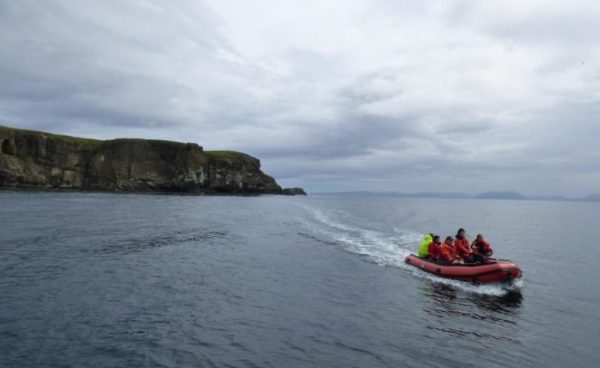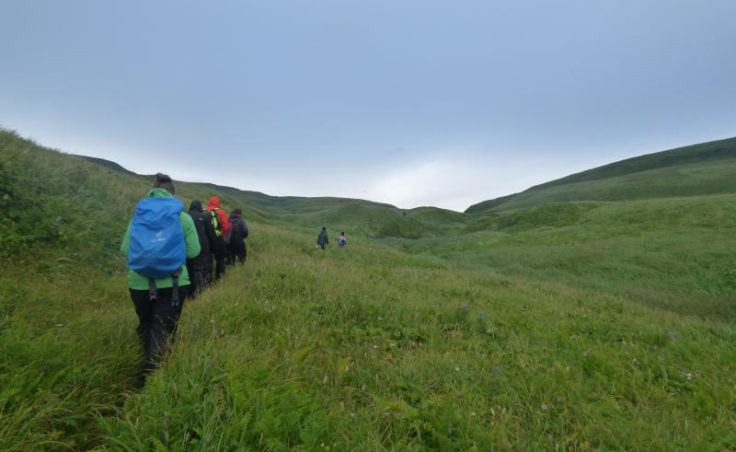
What happens when five teenagers pile onto a research vessel and go island hopping through the Aleutians in the name of conservation? Science. Education. And maybe a peek into their futures.
It’s all part of an only-in Alaska version of the federal Youth Conservation Corps or YCC. The goal is to introduce high school students to a stretch of protected land they’ve grown up near, but may not even know exists — all in the hopes that someday these young Alaskans will become its next stewards.
Over the course of a season, the research vessel Tiglax can travel 20,000 nautical miles. For a week, five YCC corpsmembers, ranging in age from 16 to 18, join the crew exploring the vastAlaska Maritime National Wildlife Refuge, which stretches from the western end of the Aleutian Chain to islands like St. Lazaria near Sitka and even further north than Point Hope.
“It’s kind of cool like being able to like be on this huge vessel and have people teach you how they do it,” Aurora Waclawski, 18, said. “It’s really interesting and awesome.”
She and the rest of the crew grew up in communities around the refuge — ranging from Homer, where she’s from, to Atka. But for most of them, this is the first time they’ve actually traveled through it.
Waclawski heads to college this fall, where she plans on studying environmental engineering. The opportunity to explore the Maritime Refuge through the YCC program has been on her bucket list for years.
“Throughout my life, I’ve loved science and all that stuff and that’s kind of why I wanted to do this,’ Waclawski said. “It’s cool kind of like seeing how this science that I’ve only really seen on paper actually goes on.”
That science she’s talking about is akin to surveying seabird colonies, and tracking the reproductive success of puffins on Aiktek.
During a week on the Tiglax, the YCC members see a sliver of the refuge, which provides essential habitat for 40 million seabirds — not to mention marine mammals and other migratory birds — but isn’t exactly a household name in the communities on is borders.

Take 18-year-old crew leader Marieana Larsen. Growing up in Sand Point, she didn’t know much about sea birds. But when she traveled to Saint Paul Island in the Pribilofs for the YCC, she says she finally understood the importance of the refuge.
“We made like 100 rat traps and I thought, ‘this is kind of pointless,’” Larsen said. “And then I thought about it and I was like, ‘oh wow birds are dying. No, rat traps are important.’ Because one rat gets on the island it could destroy all the seabirds and that’s no tourism and that’s no refuge and then people aren’t going to have their cultural foods.”
Larsen will take what she’s learned back to her community. Alongside the crew, she teaches environmental education classes at the annual culture camp in Sand Point.
“Its really fun to do classes with kindergarten through fourth grade and just kind of teach ’em different scientific things about nature because it’s not like they’re learning about it at culture camp,” Larsen said. “They’re learning about the cultural aspects.”
She hopes to bridge the gap — intertwining science with Alaska Native culture and finding more ways to connect kids to their landscape. The YCC crew are paid an hourly wage, with all their expenses covered.
Tiglax captain Billy Pepper said it’s one of the best ways the refuge spends money.
“If you’re going to try and tell somebody that wildlife and the environment is important, it’s harder to convince somebody in their 40s than in their teens,” Pepper said. “And if they get it in their teens they really become advocates for conservation.”

The experience has changed the course of some kids’ lives — giving their ambitions a real-world road test, he said.
“They come on,” Pepper said. “They think they’re going to do something and they’ve got a lot of ambition to do one thing and they’re seasick the whole time. And one kid was going to be a pilot that was the end of that. He couldn’t handle the movement. He didn’t have the make up to do it.”
For some, the experience is more successful. Larson is one of the youngest crew leaders and now, a youth ambassador with the Arctic Council. Since her first time aboard the Tiglax, Larsen slowly has been wiggling her way into the Fish and Wildlife Service, but she’s not the only one. At least four former YCC members have gone on to work for the refuge. Larsen thinks eventually she might like being a Refuge Information Technician or RIT.
“It’s like you’re the middle man for the people they want to talk to and telling them what they are doing on the refuge like with the communities close to it,” Larsen said.
That’s exactly the kind of middle men the program is hoping to create — liaisons between the refuge and the people who live near it. Right now, there is not a RIT position for the Alaska Maritime National Refuge. Staff members know Larsen is interested and said having her stationed in Sand Point representing the refuge is a possibility.
Zoe Sobel is a reporter with Alaska's Energy Desk based in Unalaska. As a high schooler in Portland, Maine, Zoë Sobel got her first taste of public radio at NPR’s easternmost station. From there, she moved to Boston where she studied at Wellesley College and worked at WBUR, covering sports for Only A Game and the trial of convicted Boston Marathon bomber Dzhokhar Tsarnaev.




